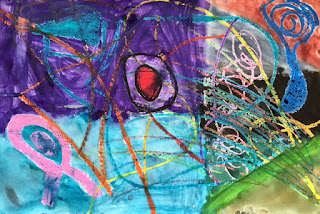The second country in our Arts Around the World journey this year is Russia. 2nd grade students began by learning about the country, including where it is located and it's capital city, Moscow.
Then we read The Noisy Paint Box: The Colors and Sounds of Kandinsky's Abstract Art. We learned that Vasily Kandinsky grew up in Russia, learning piano and math and history. His family also sent him to art classes, where they expected him to paint houses, people and flowers—like a "proper" artist.
But when Kandinsky painted, he heard sounds and connected elements of music to colors and shapes.
He wanted to show how music made him feel, and to paint a symphony of colors and shapes. He became one of the first painters of abstract art, focusing on shapes, lines, and colors, rather than recognizable objects.
 |
| Kandinsky, Composition VII (1913) |
Students first explored this idea by drawing to music, listening to different classical pieces by Russian composers that they would learn about in music class, such as Tchaikovsky, Stravinsky, Mussorgsky, and Rachmaninoff. Students used oil pastels to draw a variety of different shapes and lines, using different colors. Some students interpreted different parts of the music using darker or brighter colors, faster or lighter strokes, and curved or straight lines.
The following class, we added watercolor paint and learned about the technique of wet-on-wet. In this technique, we made the paper wet by first painting a light wash of water, then dripping or dotting paint on top. We noticed that the paint moved around and created interesting and unexpected effects.
We also noticed that the watercolor paint did not cover the oil pastel, but moved away from it. This demonstrated resist, where materials move apart. Below are some examples of our abstract artworks, inspired by Kandinsky.
 |
| Brian, 2nd Grade (Pearse) |
 |
| Eleni, 2nd Grade (O'Connor) |
 |
| Ethan, 2nd Grade (McIsaac) |
 |
| Kaylee M., 2nd Grade (Pearse) |
 |
| Shane, 2nd Grade (O'Connor) |
 |
| Sofia, 2nd Grade (O'Connor) |
|
For our second Russia art project, students learned about onion domes. We looked at an image of a building in Moscow and students pointed out the colorful shapes and patterns that they noticed, as well as the "Hershey's Kiss" shaped tops to some of the towers! We learned that these are called onion domes for their shape and they are an architectural feature first started in Russia. Onion domes are often seen on churches in Russia but have now spread to many other areas of the world and are seen on many different houses of worship.
Russian onion domes are often very colorful and brightly patterned. Students also noticed that many of the designs had textural details. We designed and drew our own buildings with onion domes using oil pastel on black paper. Using a white pencil, students first started with larger shapes and added smaller details as windows, doors, and decorative details.
Students had to include at least two onion domes in their building and although many of the buildings we looked at were symmetrical in their design, students could choose to make them asymmetrical as well. Some students chose to hold their paper horizontally and others chose to design vertically.
Students also looked at images of Russian buildings with onion domes as reference. After sketching out their design with the white pencil, students used oil pastel to add color to their work. We reviewed complementary colors and also noticed that lighter colors, like white and light pink, stood out better on the black paper than colors like dark purple. We also talked about how, if you wanted to use a darker color, you could use a contrasting lighter color around it to help it stand out.
Students spent some time on their buildings with onion domes and it shows! Below are some examples:
 |
| Aaron, 2nd Grade (McIsaac) |
 |
| Wyatt, 2nd Grade (McCarthy) |
 |
| Dayton, 2nd Grade (McCarthy) |
 |
| Ana, 2nd Grade (Pearse) |
 |
| Dylon Z., 2nd Grade (Hinds) |
 |
| Kemiyoda, 2nd Grade (Pearse) |
 |
| Paulo, 2nd Grade (Pearse) |
 |
| Noah, 2nd Grade (O'Connor) |
 |
| Mera, 2nd Grade (McIsaac) |
 |
| Evelyn, 2nd Grade (Pearse) |











































